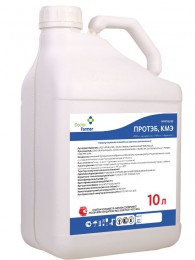
This chemical product is at the registration stage
| Eligible crops: | Cereal crops, Sunflower, Beet, Colza, Leguminous crops, Flax |
| Application: | Fungicides |
| Harmful sites: | Complex of airborne infections |
| Active materials: | propiconazole + tebuconazole |
| Concentration: | 300+200g/l |
| Chemical family: | triazoles |
| Formulation: | microemulsion concentrate |
| Packing: | canister, 10 l |
|
Consumption rate,
kg/ha
|
Culture | Harmful object |
Method, processing time,
application features
|
Waiting period (number of treatments) |
|---|---|---|---|---|
|
0,3-0,4 |
Winter, spring wheat
|
Powdery mildew, brown rust, stem rust
and yellow rust, septoria blight, pyrenophorosis, fusarium head blight
|
Spraying of vegetative weeds in late summer or autumn during the post-harvest period. Working fluid consumption ‒ 50-200 l/ha | 38(1-2) |
| Winter, spring barley |
Powdery mildew, dwarf rust, net spot
and dark brown spot, rhynchosporiasis, septoria
|
|||
| 0,3-0,4 | Rye | Powdery mildew, brown spot, septoria, rhynchosporium, brown rust, stem rust | Spraying during the growing season. Working fluid consumption – 200-400 l/ha | 40(1-2) |
|
0,3-0,4 |
Oats
|
Red-brown spot | Spraying during the growing season. Working fluid consumption - 200-300 l/ha | 38(1) |
| Millet | Helminthosporiosis, septoria | |||
| 0,5-0,6 | Spring and winter rape | Alternaria blight, powdery mildew, fomoz |
Spraying during the growing season when the first signs of one appear
from diseases in the phase of elongation of stems - the beginning of the formation of pods in the lower tier. Working fluid consumption – 200-400 l/ha
|
40(1-2) |
|
0,4-0,6 |
Soybeans |
Cercospora blight, septoria blight, ascochyta blight, alternaria blight, anthracnose
|
Spraying during the growing season. Working fluid consumption – 200-400 l/ha | 40(2) |
| 0,4-0,6 | Peas | Ascochyta blight, anthracnose, powdery mildew, rust | Spraying during the growing season at intervals of 2-3 weeks. Working fluid consumption – 200-400 l/ha | 40(2) |
| 0,4-0,6 |
Vegetable peas
|
Ascochyta blight, anthracnose, powdery mildew, rust
|
Spraying during the growing season at intervals of 2-3 weeks. Working fluid consumption – 200-400 l/ha
|
28(1-2) |
| 0,4-0,6 | Chickpeas | Ascochyta blight |
Spraying during the growing season when the first signs of disease appear, subsequent spraying
with an interval of 10-14 days. Working fluid consumption – 200-300 l/ha
|
40(2) |
| 0,4-0,6 | Sunflower | Alternaria, white rot, gray rot, phomosis, rust, phomopsis, dry rhizopus head rot, septoria | Spraying during the growing season when the first signs of one of the diseases appear in the early budding phase, subsequent spraying at intervals of 10-14 days. Working fluid consumption – 200-400 l/ha | 40(2) |
| 0,4-0,6 | Sugar beet | Cercospora blight, powdery mildew, fomoz |
Spraying during the growing season: first - when the first signs of one
from diseases, the second – after 10-14 days (if necessary). Working fluid consumption – 300 l/ha
|
30(1-2) |
| 0,3-0,4 | Fiber flax, oil flax | Anthracnose, pasmo, fusarium |
Spraying crops when the first signs of disease appear, from the “herringbone” phase to the budding phase. Working fluid consumption – 100-300 l/ha
|
-(2) |
Advantages
Mechanism of action
We will contact you shortly.